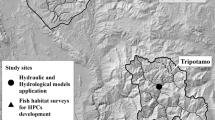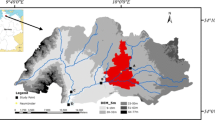Abstract
This study addressed a research concern that employing a fixed value for the bed roughness coefficient in lowland rivers (mostly sand-bed rivers) is deemed practically questionable in the presence of a mobile bed and time-dependent changes in vegetation patches. Accordingly, we set up 45 cross-sections in four lowland streams to investigate seasonal flow resistance values within a year. The results revealed that the significant sources of boundary resistance in lowland rivers with the lower regime flow were bed forms and aquatic vegetation. The study then used flow discharge as an influential variable reflecting the impacts of the above-mentioned sources of resistance to flow. The studied approach ended up with two new flow resistance predictors which simply connected the dimensionless unit discharge to flow resistance factors, Darcy-Weisbach (f) and Manning (n) coefficients. A comparison of the computed and measured flow resistance values also indicated that 87–89% of the data sets were within ± 20% error bands. The flow resistance predictors were also verified against large independent sets of field and flume data. The obtained predictions using the developed predictors might overestimate flow resistance factors by 40% for other lowland rivers. Based on a different view, according to the findings of this research, seasonal variation of vegetation abundance could show the augmentation in flow resistance values, both f and n, in low summer flows when vegetation covers river bed and side banks. The highest amount of flow resistance was observed during the summer period, during the July–August period.







Similar content being viewed by others
Availability of Data and Materials
Some or all data and models supporting the findings of this study are available from the corresponding author upon reasonable requests.
References
Barton JR, Lin PN (1955) Study of the sediment transport in alluvial channel. Rep CEF 55JRB2, Colo State Univ, Fort Collins, USA
Brownlie WR (1981) Prediction of flow depth and sediment discharge in open channels, Report No. KH-R-43A. WM Keck Laboratory of Hydraulics and Water Resources, California Institute of Technology, Pasadena, California, USA
Cai R, Zhang H, Zhang Y, Zhang L, Huang H (2020) Flow resistance equation in sand-bed rivers and its Practical application in the Yellow River. Water 12(3):727. https://doi.org/10.3390/w12030727
Champion PD, Tanner CC (2000) Seasonality of macrophytes and interaction with flow in a New Zealand lowland stream. Hydrobiologia 441(1):1–12. https://doi.org/10.1023/A:1017517303221
Chyn SD (1935) An experimental study of the sand transporting capacity of the flowing water on sandy bed and the effect of the composition of the sand. Ph.D. thesis, Mass Inst of Technol, Cambridge, USA
Cornacchia L, Wharton G, Davies G, Grabowski RC, Temmerman S, Van Der Wal D et al (2020) Self-organization of river vegetation leads to emergent buffering of river flows and water levels. Proc Royal Soc B 287:20201147. https://doi.org/10.1098/rspb.2020.1147
Costello WR (1974) Development of bed configuration in coarse sands. Rep. 74–1, Dep of Earth and Planet Sci, Mass Inst of Technol, Cambridge, USA
Daves TR (1971) Summary of experimental data for flume tests over fine sand. Report, Dep of Civ Eng, Univ. of Southampton, Southampton, UK
Dulovičová R, Velísková Y, Schügerl R (2020) Determination and comparison of hydraulic conductivity values of bed silts along Chotárny channel using grain size analysis. Acta Hydrol Slovaca 21(2):139–144. https://doi.org/10.31577/ahs-2020-0021.02.0017
Ferguson R (2007) Flow resistance equations for gravel‐and boulder‐bed streams. Water Resour Res 43(5). https://doi.org/10.1029/2006WR005422
Ferguson R (2010) Time to abandon the Manning equation? Earth Surf Process Landf 35(15):1873–1876. https://doi.org/10.1002/esp.2091
Franco JJ (1968) Effects of water temperature on bed-load movement. J Water Harbors Div Am Soc Civ Eng 94(3):343–352
Franklin P, Dunbar M, Whitehead P (2008) Flow controls on lowland river macrophytes: a review. Sci Total Environ 400(1–3):369–378. https://doi.org/10.1016/j.scitotenv.2008.06.018
Green JC (2005) Modelling flow resistance in vegetated streams: review and development of new theory. Hydrol Processes 19(6):1245–1259. https://doi.org/10.1002/hyp.5564
Guy HP, Simons DB, Richardson EV (1966) Summary of alluvial channel data from flume experiments, 1956–61. U.S. Geol Surv Prof Pap, 462–I
Horstman EM, Bryan KR, Mullarney JC, Pilditch CA, Eager CA (2018) Are flow-vegetation interactions well represented by mimics? A case study of mangrove pneumatophores. Adv Water Resour 111:360–371. https://doi.org/10.1016/j.advwatres.2017.11.018
Kastridis A, Theodosiou G, Fotiadis G (2021) Investigation of flood management and mitigation measures in ungauged NATURA protected watersheds. Hydrology 8(4):170. https://doi.org/10.3390/hydrology8040170
Laursen EM (1958) The total Sediment Load of Streams. J Hydraul Div 84(1):1–36
Moriasi DN, Arnold JG, Van Liew MW, Bingner RL, Harmel RD, Veith TL (2007) Model evaluation guidelines for systematic quantification of accuracy in watershed simulations. Trans ASABE 50(3):885–900. https://doi.org/10.13031/2013.23153
Namaee MR, Sui J, Whitcombe T (2017) A revisit of different models for flow resistance in gravel-bed rivers and hydraulic flumes. Int J River Basin Manag 15(3):277–286. https://doi.org/10.1080/15715124.2017.1287710
O’Hare MT, Baattrup-Pedersen A, Baumgarte I, Freeman A, Gunn ID, Lázár AN et al (2018) Responses of aquatic plants to eutrophication in rivers: a revised conceptual model. Front Plant Sci 9:451. https://doi.org/10.3389/fpls.2018.00451
O’Hare MT, McGahey C, Bissett N, Caile C, Henville P, Scarlett P (2010) Variability in roughness measurements for vegetated rivers near base flow. England and Scotland J Hydrol 385(1–4):361–370. https://doi.org/10.1016/j.jhydrol.2010.02.036
Okhravi S, Eslamian S (2022) Form resistance prediction in gravel-bed rivers. Flood Handbook. CRC Press, Taylor and Francis Group, pp 125–138
Okhravi S, Gohari S (2020) Form friction factor of armored riverbeds. Can J Civ Eng 47(11):1238–1248. https://doi.org/10.1139/cjce-2019-0103
Rickenmann D, Recking A (2011) Evaluation of flow resistance in gravel-bed rivers through a large field data set. Water Resour Res 47(7). https://doi.org/10.1029/2010WR009793
Riis T, Biggs BJ (2003) Hydrologic and hydraulic control of macrophyte establishment and performance in streams. Limnol Oceanogr 48(4):1488–1497. https://doi.org/10.4319/lo.2003.48.4.1488
Schügerl R, Velísková Y, Kimličková T (2019) Comparison of the discharge and flow velocity values determined by ADV device and indicator method. In IOP Conference Series: Earth and Environmental Science, IOP Publishing 362(1):012056. https://doi.org/10.1088/1755-1315/362/1/012056
Singh J, Knapp HV, Arnold JG, Demissie M (2005) Hydrological modeling of the Iroquois River watershed using HSPF and SWAT 1. J Am Water Resour Assoc 41(2):343–360. https://doi.org/10.1111/j.1752-1688.2005.tb03740.x
Sokáč M, Schügerl R, Velísková Y, Dulovičová R (2020) Influence of aquatic vegetation on dispersive parameters as a part of hydrodynamic conditions in natural streams. In IOP Conference Series: Earth and Environmental Science, IOP Publishing 609(1):012037. https://doi.org/10.1088/1755-1315/609/1/012037
Šoltész A, Baroková D, Červeňanská M, Mydla J, Čubanová L, Kovaľ F (2021) Possibilities of water storage in drainage channel system of the upper Rye Island. In IOP Conference Series: Earth and Environmental Science, IOP Publishing 906(1):012110. https://doi.org/10.1088/1755-1315/906/1/012110
Song S, Schmalz B, Fohrer N (2014) Simulation and comparison of stream power in-channel and on the floodplain in a German lowland area. J Hydrol Hydromech 62(2):133–144. https://doi.org/10.2478/johh-2014-0018
Song S, Schmalz B, Xu YP, Fohrer N (2017) Seasonality of roughness-the indicator of annual river flow resistance condition in a lowland catchment. Water Resour Manage 31(11):3299–3312. https://doi.org/10.1007/s11269-017-1656-z
Sulaiman MS, Sinnakaudan SK, Azhari NN, Abidin RZ (2017) Behavioral of sediment transport at lowland and mountainous rivers: a special reference to selected Malaysian rivers. Environ Earth Sci 76(7):300. https://doi.org/10.1007/s12665-017-6620-y
Thomas H, Nisbet TR (2007) An assessment of the impact of floodplain woodland on flood flows. Water Environ J 21(2):114–126. https://doi.org/10.1111/j.1747-6593.2006.00056.x
Vanoni VA, Hwang LS (1967) Relation between bed forms and friction in streams. J Hydraul Div 93(3):121–144
Willemsen PW, Horstman EM, Bouma TJ, Baptist MJ, Van Puijenbroek ME, Borsje BW (2022) Facilitating salt marsh restoration: the importance of event-based bed level dynamics and seasonal trends in bed level change. Front Mar Sci. https://doi.org/10.3389/fmars.2021.793235
Yang SQ, Tan SK, Lim SY (2005) Flow resistance and bed form geometry in a wide alluvial channel. Water Resour Res 41(9). https://doi.org/10.1029/2005WR004211
Acknowledgements
The authors gratefully acknowledge the financial support of project No. VEGA 2/0025/19 and VEGA 2/0085/20. The authors also wish to express their thanks to Prof. Nicola Fohrer and Dr. Song Song for sending their collected field data from a lowland river in Northern Germany.
Funding
The research work was supported by the VEGA (Vedecká grantová agentúra), Scientific Grant Agency of the Ministry of Education, Science, Research and Sport of the Slovak Republic (Grant numbers [VEGA 2/0025/19, VEGA 2/0085/20]).
Author information
Authors and Affiliations
Contributions
Saeid Okhravi: Study conception and design, Formal analysis and investigation, Methodology, Data curation, Visualization, Writing–original draft, Writing–review and editing. Radoslav Schügerl: Material preparation, Funding acquisition, Data collection, curation, and analysis. Yvetta Velísková: Conceptualization, Funding acquisition, Methodology, Supervision, Validation, Writing–review and editing.
Corresponding author
Ethics declarations
Ethics Approval
Not applicable.
Consent to Participate
Not applicable.
Consent to Publish
Not applicable.
Conflict of Interests
The authors have no conflicts of interest relevant to the content of this article. The authors have no relevant financial or non-financial interests to disclose.
Additional information
Publisher's Note
Springer Nature remains neutral with regard to jurisdictional claims in published maps and institutional affiliations.
Rights and permissions
About this article
Cite this article
Okhravi, S., Schügerl, R. & Velísková, Y. Flow Resistance in Lowland Rivers Impacted by Distributed Aquatic Vegetation. Water Resour Manage 36, 2257–2273 (2022). https://doi.org/10.1007/s11269-022-03139-8
Received:
Accepted:
Published:
Issue Date:
DOI: https://doi.org/10.1007/s11269-022-03139-8




